Greenwich Village features four streets that run northwest to southeast, in a sort of subgrid set off against Manhattan’s general grid which runs west to east. The four are Bedford, Bleecker, West 4th and Waverly Place. Greenwich’s Village’s grid is rather complicated, as there are two separate orientations of northwest-southeast streets. Grove, Barrow, Morton, Leroy, and Clarkson/Carmine all have a bend in them to mark a property line that dates to 1633 — the property line between the Jan Van Rotterdam and Wouter Van Twiller farms. That bend serves to change the orientation of Greenwich Village’s two separate subgrids, as you can see on a map of the region.
The Village, with its bends in the roads, hidden courts, enclaves, singular shops, and ancient watering holes (sadly, Chumley’s on Bedford, where the ForgottenBook celebration was held in September 2006, has been in limbo ever since a devastating wall collapse occurred a couple months later) has always held interest for me. I recently walked the lengths of both Greenwich Avenue and Waverly Place (Bleecker Street appeared in FNY in 2009) just to see what was there.
Waverly Place presents two separate atmospheres, as its western end is very much one of those leaf- covered lanes lined with obscurities the guidebooks present as quintessential Village. East of there Waverly changes its name and runs across the north end of Washington Square before ending in a thicket of tall New York University Buildings at Broadway. Or more properly, beginning, as the house numbers run west from Broadway in this part of town — north of Washington Square, 5th Avenue becomes the divider.
Waverly, which runs in the line of where West 6th Street would be (at least till it curves northwest at Christopher) was very early on known by that name. But in 1833 locals wanted to honor novelist Sir Walter Scott a year after his death, but instead of renaming 6th as Scott Street, chose the name of one of his novels, Waverley (a story of the Jacobite Revolution in 1745 Scotland), but misspelling it as Waverly. A couple of decades later, Factory Street, the portion that runs northwest to southeast, was made an extension of Waverly Place and the street as we know it was completed.
The Factory Street name came from a factory producing carding equipment for the textile industry run by a Samuel Whittemore that replaced an even earlier designation, Catherine Street.
The above 1850 map by Thomas Cowperthwait shows Waverly Place running (roughly) west to east, then Factory Street northwest to Troy (West 12th) Street, a block longer than it runs today.
Waverly and Bank in 2011, in the full throes of autumn. The street is named for the Bank of New York, which was founded by Alexander Hamilton in 1784 and merged with merged with Mellon Financial on 7/2/2007, becoming the Bank of New York Mellon. The townhouses in the photo were built in 1837.
The Waverly Inn, on the SW corner, is a semi-private club/restaurant owned by magazine publisher Graydon Carter (Spy, Vanity Fair), known for its $80+ macaroni and cheese (which includes expensive truffles in the recipe). If you’re a well-known name you can get in easily, but it’s not quite as easy for the hoi polloi. The phone number isn’t listed, so no reservations are taken. There has been a restaurant/tavern on the site since 1920.
Completed in 1974, St. John’s In The Village Episcopal Church at Waverly and West 11th is a relatively new addition to the Village scene. [It replaced] a Greek Revival sanctuary on the same site which burned down in 1971. The design of the new building by Edgar Tafel combines modernism with evocations of the Greek Revival style. The church is located within the Greenwich Village Historic District. From Abyssinian to Zion
The extension of 7th Avenue south from Greenwich Avenue to Clarkson and Varick Streets beginning in 1912 to accommodate the new IRT Subway created some many-faceted intersections, such as the one formed by Perry Street, 7th Avenue South, and Waverly Place. The southern extensions of 6th and 7th Avenues in the 1910s and 1920s on top of subway open cuts facilitated direct traffic movement as well, since before that the only north-south routes in the West Village were narrow Greenwich and Washington Streets; West Street was clogged with shipping traffic.
In the above photo a newer building (1987) with a turret to add an older touch is cornered on Perry and 7th Avenue South, while two apartment buildings, one from the 1920s and another from several decades later, are side by side at 7th and Waverly.
Still warm enough in early November for outdoor dining in the Italian place at the 18-story Village Towers.
McCarthy Square, formed by Waverly, 7th Avenue South and Charles Street, is actually a triangle named for PFC Bernard Joseph McCarthy, the first Villager to die fighting in World War II (1942, Guadalcanal Campaign). The triangle is known for its flagpole (originally located at Flushing Meadows, World’s Fair 1939-40) and for its eclectic birdhouse collection.
Harry Chong was a laundry at Charles and Waverly that closed in 2005, but the painted window sign survives. The locale has been a speakeasy where Fats Waller played piano and later one of the Village’s first gay bars.
One of NYC’s “discreet charms” is that there are hardly any service alleys in the backs on the buildings, as other locales have, that allow residents and merchants to place garbage bags, cans, etc. in the back of the building, outside of eye- and nose-shot. In NYC, garbage must be placed on the sidewalk in front of buildings. I’d’ve recycled those FreshDirect boxes, if I were them.
Three Lives & Co., 159 West 10th at Waverly, is one of the foremost independent book stores in NYC (a form that may take on increased importance after the folding of the megachain Border’s). It occupies the ground floor of an 1829 townhouse. Named for Gertrude Stein‘s first book (1909) concerning three women living in the fictional town of Bridgepoint.
I took note of 177 Waverly Place from the pair of wyvern door lamp holders — though I’ve seen them around before. For all I know this might be a common fixture found at Home Depot. The five-story rusticated apartment house was built in 1890.
Jeffrey’s Grocery, on the NW corner of Christopher Street and Waverly, is on the ground floor of 33 Christopher/172 Waverly, called by the Landmarks Preservation Commission Greenwich Village report as a “tour de force in the art of bricklaying.” An intricate pattern is formed by interlocking bricks of varying colors. The building was constructed in 1868 for a sausage manufacturer.
Jeffrey’s Grocery is a down-home setting serving gourmet fare, with shellfish and seafood a specialty. Owner Gabriel Stulman took over nearby Fedora from its retiring longtime owner in 2009.
Northern Dispensary
A triangular plot calls for a triangular building, and that’s what the Northern Dispensary is. In an unusual quirk, Waverly Place ends at the intersection of Grove and Christopher, but also turns northwest here to its real demise at Bank Street. Thus, one side of the Northern Dispensary faces two streets: Grove/Christopher, while the other two sides face Waverly.
From 1831, when the building was completed by local artisans John Bayard and John Tucker, to the late 1980s, free medical treatment was available at the Dispensary. Though the clinic itself closed a couple of decades ago, its old signs are still there. The Greenwich Savings Bank was founded in this building in the 1830s. In that era, this was indeed a “Northern” part of New York City. According to Dispensary records, Edgar Allan Poe was once treated for a cold here in 1837, and Jenny Lind, the Swedish Nightingale, was treated here, no doubt to keep her golden pipes at peak condition.
Sharp-eyed enthusiasts will note a slight change in the color and layout of the bricks above the second floor; the third floor was a later addition, in 1854.
Between Waverly and Christopher just west of 6th Avenue is a short dogleg called Gay Street, which will merit a full ForgottenSlice shortly (as I write in November 2011) as it contains a number of handsome Federal-style buildings and has a varied lore.
The name of the street predates Greenwich Village’s gay community by several decades, but the derivation is in dispute. In Naming New York, Sanna Feirstein claims it was named for Sidney Howard Gay (1814-1888), editor of the Chicago and New York Tribunes and a prominent abolitionist, but in The Street Book, Henry Moscow says the name ‘Gay Street’ appears in the Common Council minutes of 4/12/1827 — when Sidney Howard Gay was thirteen.
At 6th and Waverly, this apartment block (Washington Court Apartments) appears as if it has been there for many decades, but it was built from 1986-1988 and in a rare feat, matches up well with the prevailing area architecture.
A couple of years ago we were in this part of town and went in the Pizzeria Uno, which had been on 6th between Waverly and Greenwich for decades. Despite having showered that morning and wearing clean clothes, we were ignored for 15 minutes; so we repaired to the Waverly Restaurant, a diner on the corner, where we were swiftly attended to and got a filling meal (which is pretty much all I want from a restaurant. Sorry food snobs). The Waverly is closed for renovation in 2011 (but so is Chumley’s, according to rumor) and the Uno is no more, having become the Onegin Restaurant, named for an Alexander Pushkin verse novel.
Next door to Onegin on 6th, it seems to be forever 1965 at this Emigrant bank branch.
Returning to Waverly, 112 and 114 are part of a row of four buildings constructed in 1826 for Thomas Mercein, a former NYC Comptroller and fire insurance company president. The buildings, of course had been much altered before they were landmarked.
108 and 110 Waverly. 108, on the left, has a rough ashlar front applied in 1906; 110, on the right, preserves the original look of the row most closely.
Since opening in 1998 Babbo has been one of the premier Italian restaurants in NYC and made a star of its flamboyant owner, Mario Batali. 110 had previously been a carriage house for department store Wanamakers’ owners.
The Washington Square Hotel. Not many hotels can claim that both Bob Dylan and Dylan Thomas stayed there but this one can… Thomas in 1950, and Zimmy in 1961, having just arrived in NYC from Minnesota. Other guests have included Ernest Hemingway, Joan Baez, Bo Diddley, Bill Cosby and Barbra Streisand. It opened as The Hotel Earle in 1902:
The Washington Square Hotel was built in 1902 as a residential hotel named the Hotel Earle after its first owner, Earle S. L’Amoureux. The hotel occupied a single, eight-story, red brick building on Waverly Place, in the heart of Greenwich Village, now an historic landmark district. In 1908, L’Amoureux built an identical connecting building to create a grand apartment hotel, complete with reading rooms, restaurant and banquet facilities. Four years later, he added a ninth floor and, in 1917, he acquired an adjoining three-story building, bringing the hotel to MacDougal Street, at the northwest corner of picturesque Washington Square. Hotel Interactive
33 Macdougal/27-28 Washington Square North is called the Richmond Hill Apartments, after a colonial estate in what is today the West Village, buily by Major Abraham Mortier in the 1770s and later used by General George Washington as a headquarters, and later owned by 3rd Vice President and killer of Alexander Hamilton, Aaron Burr. Matthew (Ferris Buehler) Broderick is a former resident.
On the southeast corner of Washington Square Park North and West is the “hanging tree” of Washington Square Park. According to legend, this 300-year old elm was the site for numerous public hangings when the park was a potters field from 1787-1825 (it then became a drill area for military bands and a park in 1850). However, only one public hanging in the field is on city records, and that was near Minetta Brook, which ran in a different part of the field.
Waverly Place gives way to Washington Square North between University Place and Macdougal Streets. The streets surrounding the park, named Washington Squares North, South, East, West, are continuations of north-south streets and east-west streets and became the Square North, South, East, West in 1858. House numbering alternates odd and even numbers on the same sides of the streets as all buildings face the park.
The building on the SW corner of Waverly, 29 Washington Square West, was home to Eleanor Roosevelt from 1945-1949. I was drawn to that magnificent hawsered awning that protects residents in wet weather.
Magnificent townhouses line Washington Square North from University Place west to MacDougal. These, just east of Macdougal were, in the 1830s, originally home to New York’s more prominent bankers and businessmen. Detailed descriptions can be found in the 1969 Landmarks Preservation Commission Report (Washington Square North, Section 4).
#18, demolished in 1952 to make way for the #2 5th Avenue apartment house, was the home of novelist Henry James’ maternal grandmother, Elizabeth Walsh (she shares a name with your webmaster’s mother). James’ 1880 novel Washington Square was a literary sensation.
Passing 5th Avenue at Washington Square is impossible without mentioning its magnificent Arch, designed by Stanford White and constructed from 1888-1892 to celebrate the centennial of George Washington’s inauguration as first President at Federal Hall on Wall Street in 1790. Polish master pianist Jan Paderewski gave a benefit concert to aid in fundraising. This is one of two of Manhattan’s magnificent arches; the other one is at the Bowery and Canal Street at the Manhattan Bridge Manhattan entrance.
Two statues of Washington celebrate his status as a soldier and a statesman. On the east side, facing north, is General Washington accompanied by Fame and Valor, by Hermon Atkins
MacNeil; on the west side, is Washington flanked by Wisdom and Justice by Alexander Sterling Calder. Marble is especially susceptible to ruin from pollution, and these statues practically had to be resculpted when they were renovated in the early 2000s.
5th Avenue begins at Washington Square and runs in an unbroken, uncurving route from here to 120th Street, the southern end of Marcus Garvey (Mount Morris) Park.
For the first time in about a decade (as of 2011) Washington Square is free and clear of construction closings. The biggest part of the reconstruction involved moving the fountain, the site of impromptu music performances (and unofficial skateboard park) to line up with the Arch, which prompted a lot of catcalls from Village residents who were losing much of the park for a few years. Across the park is the campanile of the Judson Memorial Baptist Church on LaGuardia Place — also a Stanford White design (1888-1896). The church has been an epicenter of social activism throughout its history.
A brace of park lamps that resemble gaslights, complete with ladder rests for the lamplighter, were installed as part of the renovations.
The most celebrated of Washington Square North’s townhouses are between University Place and 5th Avenue, called simply “The Row” by its enthusiasts. Most were constructed in the early 1830s.
Numbers 7-13, before Landmarking, had their interiors divided into multiple apartments as part of Richard Randall’s Sailors Sung Harbor development, and are now only accessible from 5th Avenue. Snug Harbor later moved to the north shore of Staten Island.
In an adaptation of James’ Washington Square, Olivia de Havilland rejected the dishonorable Montgomery Clift in 1949’s “The Heiress” here, while Will Smith battled zombies in “I am Legend” in 2007.
On the northeast corner of Waverly Place and University Place , catercorner from the park, stands #1 University, a former home of playwright Clifford Odets and occultist Aleister Crowley.
#1 and #3 Washington Square North. #3 was home to my favorite painter, Edward Hopper, for most of his career. I visited his apartment as part of Open House New York in 2008. John Sloan developed his Ashcan School of Art here; its realist attitude no doubt inspired Hopper.
Hemmerdinger Hall or the Silver Center of Arts and Science, the main building of New York University (SE corner of waverly and Washington Square East) was constructed in 1895 (Arthur Zucker). The original tenant was the American Bank Note Company and Schools of Commerce, Law and Pedagogy. The Grey Art Gallery is within. The Hall replaced an earlier building where one of the first photo portraits was produced by John W. Draper, where Walt Whitman taught poetry, where Samuel Colt developed the revolver and where Samuel Morse invented telegraphy (1840s).
The four corners of Waverly Place and Greene Street are dominated by Beaux-Arts buildings belonging to NYU.
A tablet on the southwest corner identifies the address.
12 Waverly (the center building in the photo), between Greene and Mercer, is outside the Landmarks protected area, and so documentation on the web is hard to find. It’s likely from the 1880s and features a wildly eclectic window treatment.
Waverly Place ends (or rather begins, according to house numbers) at Broadway, giving it two T-square intersections — rare in New York City. Note the shorter building in the middle with the black corbelling.
732 Broadway was built in 1854 and altered around 1900. In that year the building was leased to Richard Treffurth, who ran a restaurant here in years on either side of 1900. The restaurant has lived on in the cursive lettering on the roofline. In recent years it was newly repainted. More details have proven elusive.
Souces:
Greenwich Village and How It Got That Way, Terry Miller, Crown 1990
New York Songlines, Jim Naureckas
AIA Guide to NYC [2010 edition], Norval White, Elliot Willensky, Fran Leadon
11/21/11





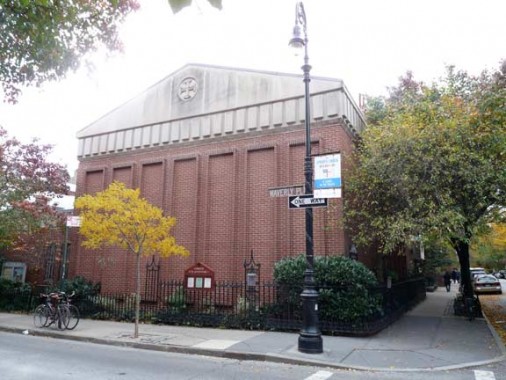






















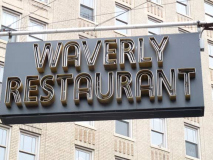
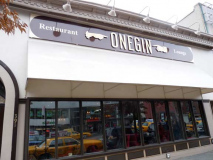







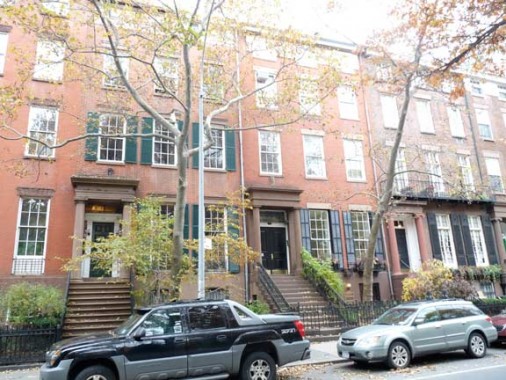















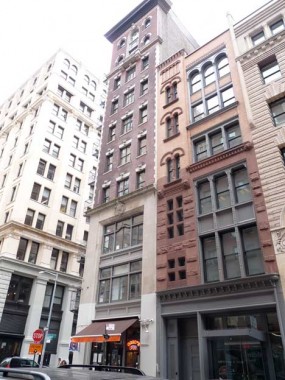


37 comments
1 of new yorks more plesant streets
Kevin, for me this is the heart of New York. The Village and the neighborhoods that radiate around it are the aorta and Waverly has to be one of the ventricles. Great post, you always illuminate the city in great detail.
Hi,
great guide. Any infos on 11 Waverly Pl by any chance? I used to live there about a decade ago. Always wondered abo7t the history of that building. Built around 1880, may a former hotel? Great times…
Cheers,
Carsten.
Only one thing missing from this fine article about Waverly Place – a photo of the street signs at the intersection of Waverly Pl and Waverly Pl.
LOL
Bob
I may be wrong on this, but I believe the :”ladder rests” on the gaslights were not ladder rests, but the gas valve. the lamplighter carried a pole with a hook and a burning rope (??) on the end. He turned the gas on with the hook and lit the gas with the rope.
Those are ladder rests. We have gaslights in my town, and I have seen the maintenance man rest his ladder on them. You don’t need the ladder to turn the gas on and off daily, but you do need it to change the mantles.
The Blubbo — sorry, Babbo — site was once a very old-fashioned restaurant called the Coach House. It was reminiscent of eating on a dining car being served by white-jacketed Pullman porters
Wow! I remember that now that you mention it.
My father lived in the building on the left in the first photo, 240 Waverly Place, from 1966 to 2010, when at age 94 he could no longer handle the 4 flights up to his apartment.
I lived in a sub let at 240 for 5 years while at NYU and then beginning my career. When my Dad moved in, everyone knew each other . As a kid when I came to visit, if he wasn’t home I could ring one of his neighbors who would let me in and give me a spare set of keys to his apartment.
It was that kind of building filled with the best neighbvors anyone could ever have. When I helped pack his things as we moved him to a new 16th floor apartment at University Village (he was made Professor Emeritus at NYU Tisch School of the Arts and the apartment is free), we reminisced and realized that he was the last one of the tenants from 1966 to move out of the building.
I remember the night that St. Johns Church burned. My Dad’s apartment was on the 4th floor South (#45) so the fire was literally in our faces. The photos mty Dad took that night were used by St. Johns in the fundraising to rebuild.
Crawdaddy Magazine , an Alternative Rock Magazine that lost out in longevity to Rolling Stone, was started in my Dad’s apartment by 2 young kids who sublet the place one summer while my Dad was working in India and Japan.
Some of the neighbors on the block were Meryl Streep, Annie Lebovitz, Mitchell Ryan and for a while Robert Clary (LeBeu from Hogan’s Heroes and a well known cabaret singer) sub let the apartment next door (the one I sub let when I was at NYU).
I have very strong and wonderful memories of life on Waverly Place.
I remember when the church burned, I was 11 then and a friend and I explored the ruins, all that was left was the exterior walls and columned facade, we were
exploring the hole left from the ground floor collapse into the basement and found boxes full of 100 year old glass magic lantern slides, and then someone like a pastor came hrough the door from I guess the attached rectory and told us to get out.
Thank you for the fantastic guide on Waverly Pl. if I’m not mistaken under your Four Buildings on Waverly(area around NYU) the one building belonged to the notorious Triangle Shirtwaist Co. As an NYU alum, I recall the building is now referred to as the Brown Bldg.
Kind Regards,
Tim Ponstingle
27 Washington Square was also home to Herbert Bergof and Utah Hagen, of the famous acting school on Bank street. Matthew Broderick was very frightened of running into them in the elevator. Also, the northern dispensary was a dental clinic at least since the 60s till it closed, I believe you can still see the old machines through the windows.
I have lived at 15 Charles St. (corner of Waverly) since 1970. The building was built in mid 1960’s by my husband’s father.
I also remember the fire at the church and watching it from our terrace. I think the new building is nowhere near as charming as the old one.
And thank you BabyDave for giving me the name of the old Coach House. Ate there many times. It was an old fashioned dress up kind of place.
By the way – I don’t remember Harry Chongs as being a gay bar. I only knew it as the chinese laundry that I used on a regular basis. Wonder if you meant Julius which is on the next corner?
Also, the Northern Dispensary definitely had a dental clinic. Had a classmate working there after graduation in 1981.
Fond memories. Thanks.
The Waverly Restaurant, somewhat against expectations, has now reopened, with more seating.
However, contrary to the statement in the story, Washington Square Park is still not free of construction, as the southwest corner is still fenced in. Like all the construction in this project, the workers do a part of the task, take a month or two off, and then come back to do the next part. After only two years, the work is completed–piece of cake! Why this small section could not have been done at the same time as the larger area completed in 2010 is very unclear. Perhaps the contractors get bored of adding benches, and so they want a break of a year or two after putting in the benches in one section before coming back and adding them in the other….
For a novel I’m writing set in 1968 — does anyone remember the name of an Italian restaurant serving mostly northern-style Italian food that was on one of those triangular corners somewhere near Sheridan square. Thanks!
What a wonderful way to get a look at one of the greatest parts of the city (or ANY parts of the city!). I love this website 🙂
Can anyone tell me what a ‘swing’ building is?
[…] Strangely, the Northern Dispensary sits on the intersections of Grove Street, Christopher Street, Waverly Place and Waverly Place. Source: Forgotten NY. […]
Can anyone tell me where 22 Factory Street would have been located? I learned a lot from this article including that Factory Street became Waverly. However, in doing some historic research, I am trying to pinpoint 22 Factory Street as it would have been in 1827. Wish I could come and walk the street myself. But I live on the other side of the country.
I especially enjoyed the photos and explanation of the triangle where the Northern Dispensary is located. Would love to see it in person.
I would be interested in knowing if you found 22 Factory Street. My research has taken me to 24 Factory Street in about 1850 and perhaps earlier as well. Did you ever learn its location?
[…] The Northern Dispensary in Greenwich Village. Photo via Forgotten NY. […]
Anybody remember Rocky’s Bar on Waverly? It was downstairs opposite one of the NYU buildings (Brown perhaps?) and a great student hangout. Big fireplace. Dark and smoky. Cranky waiter Sam. I was back in area recently and can’t even identify the old entry. It may have closed in the 1960s.
I was a frequent visitor at Rocky’s bar during my years at Washington Sq College. (1963-1967). Entrance on Waverly Place. Down a flight of stairs to the bar. They had booths where we used to order a big plate of french fries and a pitcher of beer. They NEVER asked for proof that you were 18 yrs old.
The Northern Dispensary is on a triangle where Waverly meets Waverly, then both of them run into Christopher/Grove/Stonewall Place at different places. Meet me at the corner, anyone?
There was a bookstore at 1 University Place, must have closed around 2003, I think. Nowadays it’s a food store. Does anybody remember the name of the bookstore and/or the owner. I used to love going to that store when I was at NYU. I remember there was a cat that used to wander around the stacks.
Shakespeare and co. before it moved to Broadway (ultimately closed).
I lived in that building at 1 University in the 70s, I remember the Village Smoke shop, run by two -I think -brothers, the Aquarious restaurant which closed and the space divided in half for a pizza parlor and Flugelmeyrs deli, there was also the Chinese restaurant on the University side that had a door in the back that went to the lobby.
Does anyone remember Garvin’s Restaurant. I had my wedding there and I think it was a well known Village restaurant in the 80s.
Yes, Jennifer Deare, I do remember, We threw a Bar Mitzvah Celebration for my son there, , about 1988. It was well appointed, and quite large!
Yes. I lived around the corner on Mercer. An elegant, classy place with piano. Last time we were there was probably 1982. I think a vegetarian fusion Asian place came afterwards. It’s funny how it just popped into my head today, and I googled it.
I remember eating there several times and a friend of ours sang in the restaurant.
I worked at Garvin’s as a waitress for several years in the ‘80’s. It was a lovely restaurant and I enjoyed working there.
Does anyone know when it closed and why?
Great to hear people who recall Garvin’s . Was revered by our family as the go to events format. Don’t know exactly when they faded from view.
I lived on Bleeker St.in a 6th floor walkup apt. above the CAFE WHA in 1971.The apt was
rented by an Indian guy named Barry. He was a street peddler that made. leather belts.I
paid $12 a week to stay there.There were 8 of
us living in the one bedroom apt. We were
lucky,because Barry put a toilet in the bed-
room closet,so we didn’t have to use one out in the hall.Also,we had a shower stall in the
kitchen,not a bathtub. I remember the Empire State Building was perfectly framed in a land-
ing window.That’s when I hung out at
NOBODYs , worked @ Paul Sargents, and went to Woodstock every weekend via bus( as far
as Saugertes; had to hitch a ride from there).
I’m researching 42 Waverly Place in the late 1850’s. Did these buildings have a front entrance to the basement areas beneath the steps?
Hi, The group of buildings you designated as belonging to NYU: “The four corners of Waverly Place and Greene Street are dominated by Beaux-Arts buildings belonging to NYU.” is incorrect. The building on the far left, with the former M&G restaurant, now White Oak Tavern, is a residential coop building in which I live called Waverly Mews, our address is 15-23 Waverly Place. We are not owned by NYU. In it’s early days the building was a millinery factory.
I have an antique wood pie safe with a little plaque on it that says “General Display Case Company, Inc., 155 Waverly Place, NYC” (although it is possible it says 55 Waverly Place, I’m pretty sure it’s 155). I wonder if there’s any sign of it there.